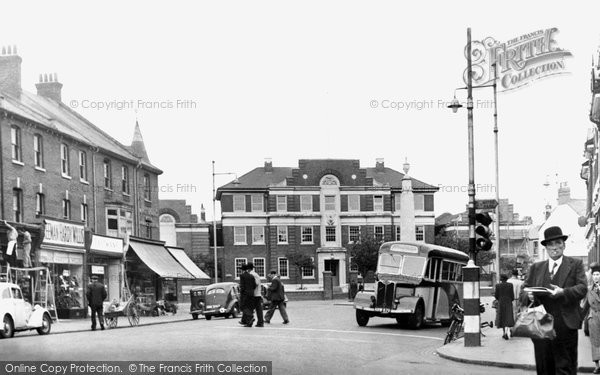Paines
A Memory of Grays.
At the age of 14 my father began work as an apprentice pawnbroker for the firm W. Paines & Co. at their Strood branch on the corner of High Street, and Station Road. The firm had 3 branches. The apprenticeship lasted 5 years, followed by a period of ‘improving’. When dad had finished his 5 year apprenticeship (age 19) he went to work at the Grays shop. In 1929-1932 he was employed as an ‘improver’ for 3 years and then from 1932 as under manager. Because of the travel distance involved he lodged during the week with a family in Brook Road, Grays. This was how he met my mother who also lived in Brook Road, no. 42. They married in 1936 at Grays Parish Church and held their reception at the old Drill Hall and set up home in Grays.
Dad was moved back to the Strood branch in 1937 and became manager. He and he and mum moved to a newly built house in the area.
Following the end of the 2nd WW my father took up the position of manager at the Grays branch. The pawnbroking side of the business continued. The items pledged included clothes and household bedding and to have a better selection to sell, if the pledges were not redeemed, extra supplies of new goods were bought. He worked there until the business was sold and subsequently the shop demolished and redeveloped sometime in the 70’s. In fact all of the 3 shops owned by the company were sold off.
Paines at Grays had a number of different departments. The front part onto the High street was the mens and boys outfitters and toy department and was managed by a Mr Lynn. Dad was manager of the rest of the shop, which fronted onto Bridge Street opposite the Queens. This included a shoe department, china department, jewellery and haberdashery and of course the pawnbrokers area.
My recall of the upstairs was that it was a very dark area with lots of wooden shelves (and not very clean). Apart from holding spare stock this was where the pawned goods were also stored – either to be redeemed by a due date or if left uncollected for a certain period of time they were then sold. Once a year the rat man used to call to clear out dead vermin and lay new poison. The smell when he was there was awful. I recall lots of the parcels in the upstairs were tied with brown paper and string. In fact this was what was used for wrapping some goods up in the shop area. (Dad was always trying to teach me how to tie a slip knot).
Each department had its own entrance door and for the jewellery, china and pawn broking sections this was the only entry for the public (although internally they could all be accessed through each other). The shoe and haberdashery sections you could walk through to.
The shop had an ‘office’ which was a partioned off, raised room area in the haberdashery department with glass windows and a door. Payments would be sent through to the office via a cash railway. A wooden container would have money and the bill placed in it and it would then be screwed into a metal holder and propelled by a catapult to the cash desk. It was operated by a handle on a rope which would be suspended from the ceiling. The assistant would pull this down and it would wind the machine up. Upon release it sped off along a wire near to the ceiling to the cash office and then any change etc. would be sorted by the cashier and returned to the department in the same way. There was a network of rail tracks along the ceilings in all the departments for this purpose. I think it was likely that this was a Rapid Wire.
I worked there during some of my school holidays when I was old enough (c. 1960’s) I can still remember the special ‘code’ that was used on the price tickets which showed what the goods had actually cost.
My father used to make the long journey from Strood to Grays each day Monday to Saturday (even for the half day Wednesday) for many, many years. This involved a 20 minute walk from home, 30 minute bus ride to Gravesend, then the old ferry over the Thames to the riverside where he used to board the train for Grays. Often when the weather was bad and there was dense fog, the ferry would not be running and then dad used to travel up and back via Blackwall. The riverside terminal used to be such a bustling area, full of people and noisy and lively. I remember the book stall and at Christmas the very large Christmas tree that was always there.
Of course by the time the shop was sold, the pawn broking side of the business was no longer operating. I can recall dad saying how there would be queues of the ‘usuals’ waiting outside for him to open on certain days. He also spoke of a particular lady called Annie who used to urinate on the floor whilst waiting there. (I can recall early on that there was straw laid on the old wooden floorboards. People would come in a small side door and into the area. Dad would stand the other side of a high counter/wall and negotiate prices etc.
Add your comment
You must be signed-in to your Frith account to post a comment.
Add to Album
You must be signed in to save to an album
Sign inSparked a Memory for you?
If this has sparked a memory, why not share it here?


Comments & Feedback